Bearded seal
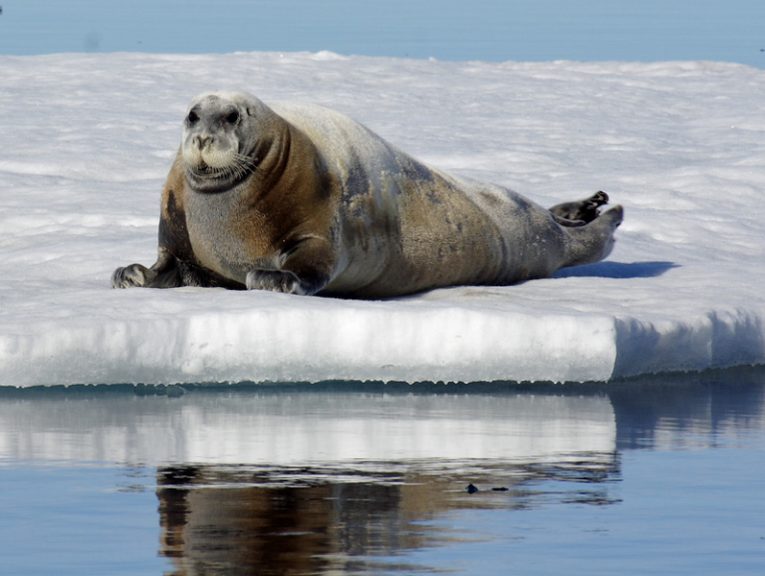
Erignathus barbatus
Size
The bearded seal is a large seal. Adult individuals grow to about 2.30 to 2.40 metres from snout to tip of tail, some growing to up to 2.50m. In summer, when the bearded seals are thin, adults weigh between 200-250kg. In late winter and in spring when they are fattest, they can reach about 400kg. Males and females are almost the same size.
Food
Food consists of fish, as well as seabed creatures, such as bristle worms, sea slugs and shellfish.
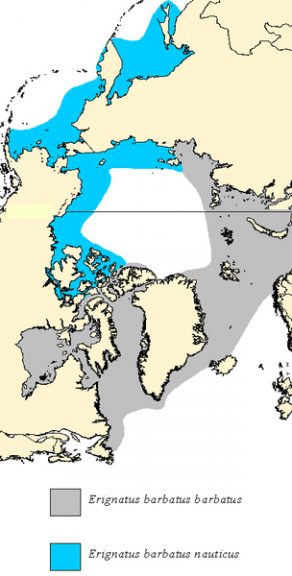
The circumpolar distribution of the two subspecies of bearded seals. Click image for larger view.
Distribution and numbers
The bearded seal is divided into two subspecies: Erignathus barbatus barbatus and E.b. nauticus. The boundaries for the distribution of the two subspecies are unclear and one cannot with total certainty determine to which subspecies a bearded seal belongs only from skeletal remains either. If we compare a large amount of data from the area around the Bering Strait or the Sea of Okhotsk with bearded seals from the Atlantic side however, there will be distinct differences in various average measurements. For example, the head of E.b. nauticus is shorter and wider.
The total world population of bearded seals is not known with certainty, but extrapolation from sub-areas where surveys have been carried out indicates that in total there are in the region of 750,000 individuals, of which approx. 500,000 are E.b. nauticus. By extrapolation, we mean that from the surveys that have been made, the average density of bearded seals on different types of ice has been calculated; for example, fast ice in the fjords, fast ice in coastal areas and pack ice. Then, from satellite maps, it has been calculated how large the areas with the different types of ice are, and then multiplied the areas by the average densities of bearded seals.
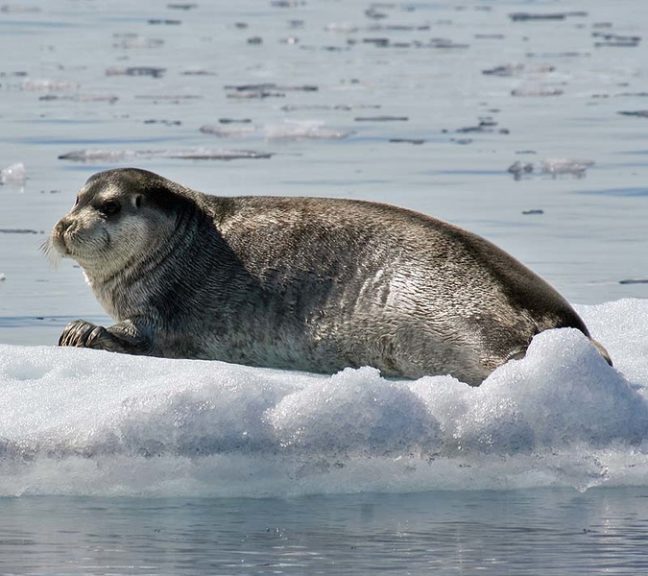
Bearded seal pup on the ice. Photo: Aqqalu Rosing-Asvid
Reproduction
As with the other Greenland seal species, bearded seals usually become sexually mature around the age of five (some a year or two earlier or later). The bearded seal gives birth to her pup in April-May on drift ice or edges of ice with access to open water. At birth, the pup measures about 1.30m and weighs around 35kg. It suckles for around 24 days and in this period puts on just over 3kg a day, so it usually weighs a little over 100kg when it leaves its mother. The pup is ready to go into the water a few hours after it is born and, little by little, it begins to find food for itself, while still suckling.
During the spring, the male begins “singing” under water. He probably uses these sounds to defend his territory and to attract females. The mating season peaks in May when the pups are finished suckling. The bearded seal, like other seals, has delayed implantation, i.e. the fertilized egg divides a few times and then becomes dormant. The egg does not attach itself to the womb (implantation) before early August and then embryonic development begins.
Moulting
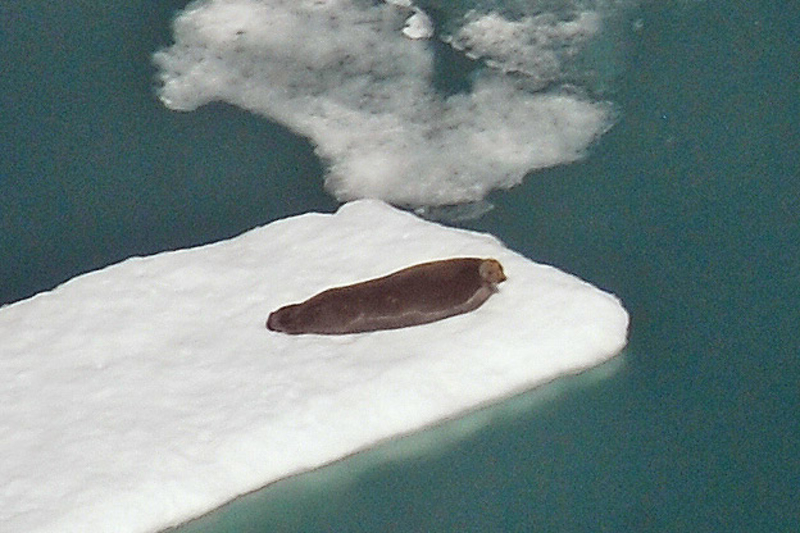
Bearded seal on ice floe. Photo: Lars Maltha Rasmussen
The bearded seal’s moulting period is difficult to define. They will typically moult heavily in the summer months from mid-June to early August. Then the seals appear to be brownish, and there will often be an imprint of the moulted hair where they have been lying on an ice floe. When the new hair appears in late summer and autumn, it is silver-grey and many adult Greenland bearded seals will have a white patch on the crown (see picture under “Research”). However, sometimes these silver-grey seals also moult, but this moulting is more in terms of individual hairs that can be brushed off, and this mild form of moulting can be observed in all seasons.
Status
The two subspecies of bearded seals can probably be divided into several breeding populations, i.e. groups of seals that live so separated that, for example, catches taken from the one group do not influence the numbers in the other group. In order not to overexploit the seals in some areas, the status should be given of each population, but right now we do not know enough, either about where the boundaries go between populations, or how many seals there are in the different populations. A status cannot therefore be made of bearded seals around Greenland. Yet it is assumed that the very even distribution of these seals with relatively low densities in enormous areas helps to protect them from overexploitation. In Greenland’s Red List, the bearded seal is therefore categorized as “not threatened”.
Management
There is no international governing body which regulates the hunting of bearded seals. Advice on hunting and management of bearded seals comes under NAMMCO and, if requested by a member country, then the Scientific Committee will prepare non-binding advice on the size of a sustainable catch, based on existing data.
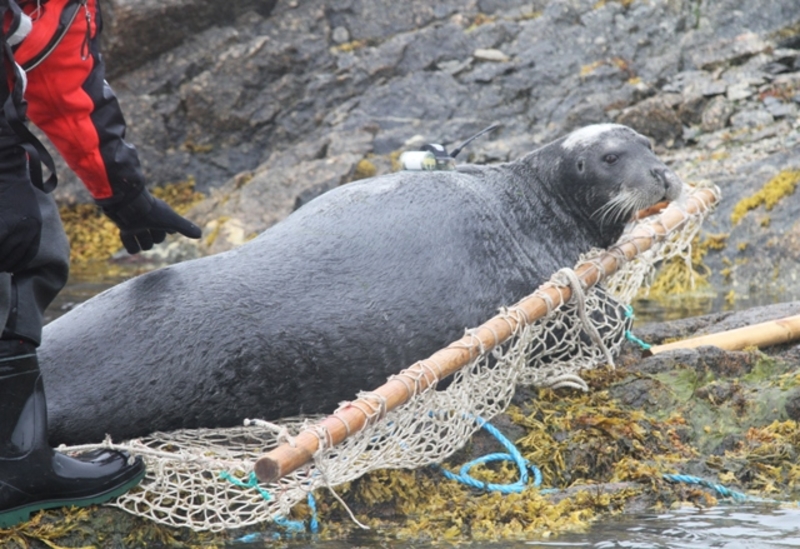
Satellite transmitter mounted on a bearded seal with new grey coat. Photo: Aqqalu Rosing-Asvid
Research
Data indicate that bearded seals like ringed seals have different strategies, some being stationary and others swimming long distances. Generally they avoid thick winter ice, but according to hunters from Northwest Greenland they can maintain breathing holes in up to one meter thick ice. Satellite telemetry have also shown that some bearded seals winter in the inner parts of Melville Bay where winter ice normally is relatively thick. Many bearded seals will, however, stay around the ice edge following the expansion of winter ice, so that they stay in areas with access to open water.

